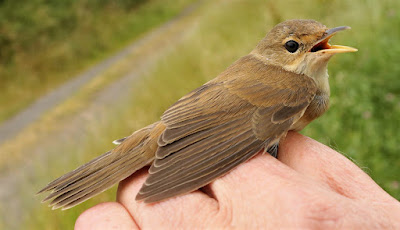The thunderstorm of Saturday moved north and east from here in coastal Lancashire and headed across the Pennines to disrupt the Headingley Test Match. There was less cricket to watch on TV but the Sunday forecast was unimpaired; a dry, bright morning with 2-5 mph and the prospect of a ringing session following weeks of inactivity.
The rain was gone when I met up with Will for a brutal 0600 start but high hopes of catching a few warblers. Viewing visits in recent days saw seven or eight singing Reed Warblers and pairs of both Reed Bunting and Sedge Warbler with plenty of feeding activity around their reed bed of choice. Surely by now, early July there would be fresh juveniles aplenty?
Our own scoreboard saw an improvement with 16 birds caught – 2 recaptures (Wren and a Reed Warbler from 2021) and 14 new birds. 6 Reed Warbler, 2 Blackbird, 3 Great Tit, 1 Blue Tit, 1 Robin and 1 Whitethroat.
Of the seven Reed Warblers just two were juveniles, the other five adults, numbers that meant we had scratched the surface, with more juveniles yet to fledge following the very slow start to breeding during the cold weeks of May. Reed Warblers need dense and tall reeds in which to hide their nests suspended between solid reed stems, growth that was sluggish and not to anyone’s liking.
A single Whitethroat was the other representative of the warbler family with no sight or sound of hoped for Blackcaps, Willow Warblers or Chiffchaffs, never mind more exotica like Lesser Whitethroats or Garden Warblers. The singing Reed Bunting stayed out of range and we never got to see the female buried somewhere in the edge of the reeds on her precious eggs,
Reed Bunting
Whitethroat
It looks as though we will have to wait a week or two more for post juvenile wanderings to begin in earnest.
Bird watching in between the ringing provided scant rewards with handfuls only of Goldfinches, Linnets and Swallows plus flybys of Grey Heron and Little Egret.
Later, I caught up with the cricket. England beat the Aussies in the Third Test. Now it’s all to play for in the following two games, Old Trafford next and then The Oval for the decider.
It’s a little like ringing. Playing to win and not giving up. You can’t keep a good team down.
































































.jpeg)







.jpg)












